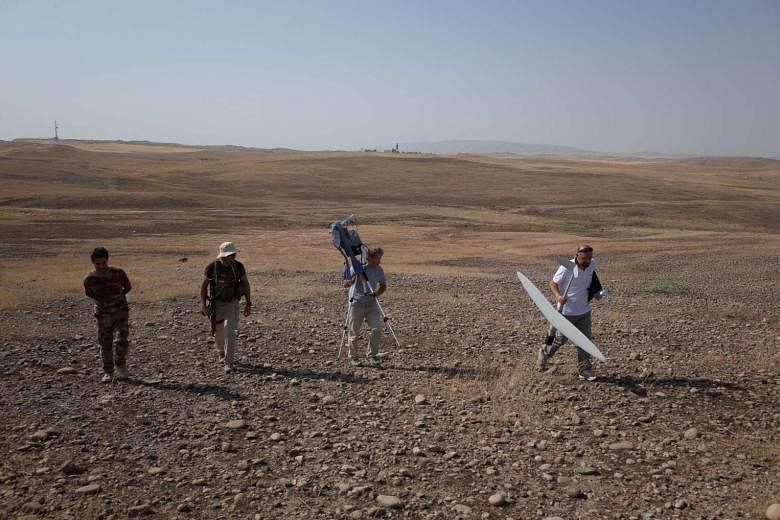PARIS • When the Islamic State in Iraq and Syria (ISIS) was about to be driven out of the ancient city of Palmyra in March, Mr Yves Ubelmann got a call from Syria's director of antiquities to come over in a hurry.
An architect by training, Mr Ubelmann, 36, had worked in Syria before the country was engulfed by war. But now there was special urgency for the kind of work his youthful team of architects, mathematicians and designers did from their cramped offices in Paris: producing digital copies of threatened historical sites.
Palmyra, parts of it already destroyed by the Islamic militants who deemed these monuments idolatrous, was still rigged with explosives. So he and his Syrian colleague Houmam Saad spent four days flying a drone with a robot camera over the crumbled arches and temples.
"Drones with four or six rotors can hover really close and register structural details, every crack and hole, and we can take very precise measurements," said Mr Ubelmann. "This is the stuff architects and archaeologists need."
They need it in a new push for virtual preservation that scientists, archaeologists and others, like himself, are compiling on a large scale. The records could be used to create computer models that would show how monuments and endangered historical sites might one day be restored, repaired or reconstructed.
Of special interest are ancient sites in Syria and Iraq that have suffered from war, looting and ISIS.
"The terrorists were uploading videos with them blowing up monuments and smashing statues to manipulate public opinion," Mr Ubelmann said. "We felt the best response was to magnify the pictures of these places and show their splendour and their importance to the culture. It became a war of images."
The latest front in that war is in the exhibition halls of the Grand Palais in Paris, where, through Jan 9, many of the 40,000 images he and his team took at Palmyra have become the basis for displays. Called Eternal Sites: From Bamiyan To Palmyra, the show aims to draw attention to the rising threats to global heritage.
To underscore the exhibition's political importance, it was opened several weeks ago by President Francois Hollande of France, who described it as "an act of resistance" against terror and intolerance. Showing the beauty of the Middle Eastern heritage, he said, "is the best answer to the Islamist propaganda of hate, destruction and death".
The Louvre's director Jean-Luc Martinez, who is also the lead curator of the show, said the sites had been chosen because "all are under threat from pillaging, neglect or destruction and are not accessible to the public". He said it aims to mobilise public opinion "in the face of the devastation of unique heritage".
Besides images from Palmyra, the multimedia show projects enormous 3D photographs and videos, immersing visitors in different eras, including the ancient Iraqi city of Khorsabad around 700BC, an eighth-century mosque in Damascus and a medieval Christian citadel.
Mr Ubelmann dismissed any criticism of collaboration with the government of Syrian President Bashar al-Assad. "We were working pro bono, not for any government, but to help the archaeologists," he said.
They shared their work with the Syrian archaeologists, he said, adding: "We also train our colleagues, so they can later do this on their own."
His team is now analysing the effects of the war on the remains of once-thriving cities dating back about 3,000 years, including Nineveh, Khorsabad and the thrashed temple and palace of Nimrud, where the government drove out the jihadis last November.
In 2015, Islamists sent out videos showing militants using sledgehammers to break reliefs of human figures and mythical winged bulls as part of their anti-idols campaign.
"Nimrud was probably the most splendid of the Assyrian cities," said Syrian architect Layla Abdulkarim as she analysed aerial photographs.
Using drones in archaeological work is not new, specialists said, but at a recent gathering in Paris, researchers from Europe and the Middle East said they were now having to practise "war archaeology", that is, collecting reliable data from off-limit areas.
The images from the drones in war zones had proved immensely valuable. But these were barely scratching the surface. Before the war, close to 150 archaeological projects were under way, just in Syria, researchers said.
Experts from many countries are trying to assess the damage in Syria's old cities, but also in the area straddling Iraq and Syria, where ISIS held sway. The region is seen as central to human history and often called the birthplace of modern economics and writing. There is an outcry for data about the havoc wreaked in Yemen by Saudi bombing.
"People are exchanging satellite images and data on blogs and other research platforms, but we have no real assessment yet because so many ancient sites are not accessible," said archaeology professor Pascal Butterlin of the Sorbonne in Paris.
Time is of the essence, even in the case of 5,000-year-old ruins, he said. He has led expeditions for more than 20 years to Mari, near Syria's border with Iraq. Before fleeing, the guards at Mari reported that looters had come from Iraq, he said.
"We need to know what places need to be stabilised and how looters have altered the sites," he added. "Important evidence, such as clandestine pits, can disappear very quickly through sandstorms and erosion."
NYTIMES


